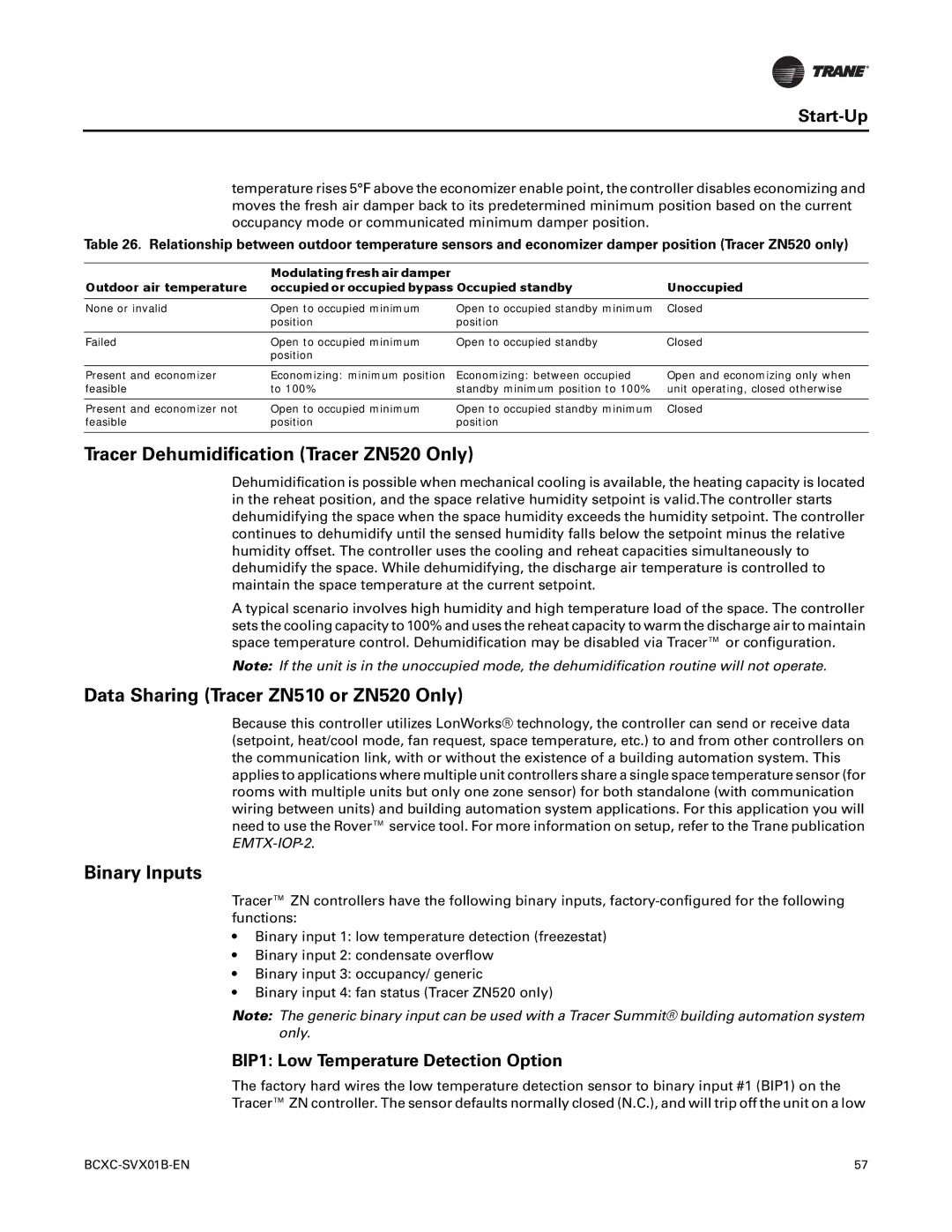
Start-Up
temperature rises 5°F above the economizer enable point, the controller disables economizing and moves the fresh air damper back to its predetermined minimum position based on the current occupancy mode or communicated minimum damper position.
Table 26. Relationship between outdoor temperature sensors and economizer damper position (Tracer ZN520 only)
| Modulating fresh air damper |
|
|
Outdoor air temperature | occupied or occupied bypass Occupied standby | Unoccupied | |
|
|
|
|
None or invalid | Open to occupied minimum | Open to occupied standby minimum | Closed |
| position | position |
|
|
|
|
|
Failed | Open to occupied minimum | Open to occupied standby | Closed |
| position |
|
|
|
|
|
|
Present and economizer | Economizing: minimum position | Economizing: between occupied | Open and economizing only when |
feasible | to 100% | standby minimum position to 100% | unit operating, closed otherwise |
|
|
|
|
Present and economizer not | Open to occupied minimum | Open to occupied standby minimum | Closed |
feasible | position | position |
|
|
|
|
|
Tracer Dehumidification (Tracer ZN520 Only)
Dehumidification is possible when mechanical cooling is available, the heating capacity is located in the reheat position, and the space relative humidity setpoint is valid.The controller starts dehumidifying the space when the space humidity exceeds the humidity setpoint. The controller continues to dehumidify until the sensed humidity falls below the setpoint minus the relative humidity offset. The controller uses the cooling and reheat capacities simultaneously to dehumidify the space. While dehumidifying, the discharge air temperature is controlled to maintain the space temperature at the current setpoint.
A typical scenario involves high humidity and high temperature load of the space. The controller sets the cooling capacity to 100% and uses the reheat capacity to warm the discharge air to maintain space temperature control. Dehumidification may be disabled via Tracer™ or configuration.
Note: If the unit is in the unoccupied mode, the dehumidification routine will not operate.
Data Sharing (Tracer ZN510 or ZN520 Only)
Because this controller utilizes LonWorks® technology, the controller can send or receive data (setpoint, heat/cool mode, fan request, space temperature, etc.) to and from other controllers on the communication link, with or without the existence of a building automation system. This applies to applications where multiple unit controllers share a single space temperature sensor (for rooms with multiple units but only one zone sensor) for both standalone (with communication wiring between units) and building automation system applications. For this application you will need to use the Rover™ service tool. For more information on setup, refer to the Trane publication
Binary Inputs
Tracer™ ZN controllers have the following binary inputs,
•Binary input 1: low temperature detection (freezestat)
•Binary input 2: condensate overflow
•Binary input 3: occupancy/ generic
•Binary input 4: fan status (Tracer ZN520 only)
Note: The generic binary input can be used with a Tracer Summit® building automation system only.
BIP1: Low Temperature Detection Option
The factory hard wires the low temperature detection sensor to binary input #1 (BIP1) on the Tracer™ ZN controller. The sensor defaults normally closed (N.C.), and will trip off the unit on a low
| 57 |
